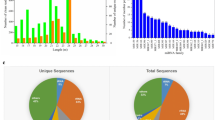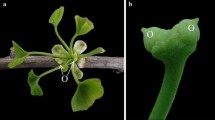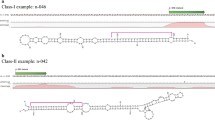Abstract
The orchid Erycina pusilla has a short life cycle and relatively low chromosome number, making it a potential model plant for orchid functional genomics. To that end, small RNAs (sRNAs) from different developmental stages of different organs were sequenced. In this miRNA mix, 33 annotated miRNA families and 110 putative miRNA-targeted transcripts were identified in E. pusilla. Fifteen E. pusilla miRNA target genes were found to be similar to those in other species. There were putative novel miRNAs identified by 3 different strategies. The genomic sequences of the four miRNAs that were identified using rice genome as the reference can form the stem loop structure. The t0000354 miRNA, identified using rice genome sequences and a Phalaenopsis study, had a high read count. The target gene of this miRNA is MADS (unigene30603), which belongs to the AP3-PI subfamily. The most abundant miRNA was E. pusilla miR156 (epu-miR156), orthologs of which work to maintain the vegetative phase by repressing the expression of the SQUAMOSA promoter-binding-like (SPL) transcription factors. Fifteen genes in the E. pusilla SPL (EpSPL) family were identified, nine of which contained the putative epu-miR156 target site. Target genes of epu-miR172, also a key regulator of developmental changes in the APETALA2 (EpAP2) family, were identified. Experiments using 5′RLM-RACE demonstrated that the genes EpSPL1, 2, 3, 4, 7, 9, 10, 14 and EpAP2-9, -10, -11 were regulated by epu-miR156 and epu-miR172, respectively.






Similar content being viewed by others
References
Altschul SF, Gish W, Miller W, Myers EW, Lipman DJ (1990) Basic local alignment search tool. J Mol Biol 215:403–410
An FM, Hsiao SR, Chan MT (2011) Sequencing-based approaches reveal low ambient temperature-responsive and tissue-specific microRNAs in phalaenopsis orchid. PLoS ONE 6:e18937
Aukerman MJ, Sakai H (2003) Regulation of flowering time and floral organ identity by a MicroRNA and its APETALA2-like target genes. Plant Cell 15:2730–2741
Bailey TL, Boden M, Buske FA, Frith M, Grant CE, Clementi L, Ren J, Li WW, Noble WS (2009) MEME SUITE: tools for motif discovery and searching. Nucleic Acids Res 37:W202–W208
Birkenbihl RP, Jach G, Saedler H, Huijser P (2005) Functional dissection of the plant-specific SBP-domain: overlap of the DNA-binding and nuclear localization domains. J Mol Biol 352:585–596
Calderon-Villalobos LIA, Kuhnle C, Dohmann EMN, Li H, Bevan M, Schwechheimer C (2005) The evolutionarily conserved TOUGH protein is required for proper development of Arabidopsis thaliana. Plant Cell 17:2473–2485
Chang WC, Lee TY, Huang HD, Huang HY, Pan RL (2008) PlantPAN: plant promoter analysis navigator, for identifying combinatorial cis-regulatory elements with distance constraint in plant gene groups. BMC Genomics 9:561
Chase MW, Hanson L, Albert VA, Whitten WM, Williams NH (2005) Life history evolution and genome size in subtribe Oncidiinae (Orchidaceae). Ann Bot 95:191–199
Chen X (2004) A MicroRNA as a translational repressor of APETALA2 in Arabidopsis flower development. Science 303:2022–2025
Chen X (2009) Small RNAs and their roles in plant development. Annu Rev Cell Dev Biol 25:21–44
Chi X, Yang Q, Chen X, Wang J, Pan L, Chen M, Yang Z, He Y, Liang X, Yu S (2011) Identification and characterization of microRNAs from peanut (Arachis hypogaea L.) by high-throughput sequencing. PLoS ONE 6:e27530
Chiu YT, Lin CS, Chang C (2011) In vitro fruting and seed production in Erycina Pusilla (L.) N. H. Willams and M. W. Chase. Propag Ornam Plants 11:131–136
Chou ML, Shih MC, Chan MT, Liao SY, Hsu CT, Haung YT, Chen JJ, Liao DC, Wu FH, Lin CS (2013) Global transcriptome analysis and identification of a CONSTANS-like gene family in the orchid Erycina pusilla. Planta. doi:10.1007/s00425-013-1850-z
Chuck G, Cigan AM, Saeteurn K, Hake S (2007) The heterochronic maize mutant Corngrass1 results from overexpression of a tandem microRNA. Nat Genet 39:544–549
Cuperus JT, Fahlgren N, Carrington JC (2011) Evolution and functional diversification of MIRNA genes. Plant Cell 23:431–442
Dai X, Zhao PX (2011) psRNATarget: a plant small RNA target analysis server. Nucleic Acids Res 39:W155–W159
Felix LP, Guerra M (1999) Chromosome analysis in Psygmorchis pusilla (L.) Dodson and Dressler: the smallest chromosome number known in Orchidaceae. Caryologia 52:165–168
Griffiths-Jones S, Saini HK, van Dongen S, Enright AJ (2008) miRBase: tools for microRNA genomics. Nucleic Acids Res 36:D154–D158
Hsu CT, Liao DC, Wu FH, Liu NT, Shen SC, Chou SJ, Tung SY, Yang CH, Chan MT, Lin CS (2011) Integration of molecular biology tools for identifying promoters and genes abundantly expressed in flowers of Oncidium Gower Ramsey. BMC Plant Biol 11:60
Hunter C, Poethig RS (2003) miSSING LINKS: miRNAs and plant development. Curr Opin Genet Dev 13:372–378
Jamalkandi SA, Masoudi-Nejad A (2009) Reconstruction of Arabidopsis thaliana fully integrated small RNA pathway. Funct Integr Genomics 9:419–432
Karimi M, Inze D, Depicker A (2002) GATEWAY vectors for Agrobacterium-mediated plant transformation. Trends Plant Sci 7:193–195
Kim S, Soltis PS, Wall K, Soltis DE (2006) Phylogeny and domain evolution in the APETALA2-like gene family. Mol Biol Evol 23:107–120
Kimura M (1980) A simple method for estimating evolutionary rates of base substitutions through comparative studies of nucleotide sequences. J Mol Evol 16:111–120
Klein J, Saedler H, Huijser P (1996) A new family of DNA binding proteins includes putative transcriptional regulators of the Antirrhinum majus floral meristem identity gene SQUAMOSA. Mol Gen Genet 250:7–16
Lee DY, Lee J, Moon S, Park SY, An G (2007) The rice heterochronic gene SUPERNUMERARY BRACT regulates the transition from spikelet meristem to floral meristem. Plant J 49:64–78
Ling LZ, Zhang SD (2012) Unraveling the distribution and evolution of miR156-targeted SPLs in plants by phylogenetic analysis. Plant Div Res 34:33–46
Llave C, Xie Z, Kasschau KD, Carrington JC (2002) Cleavage of Scarecrow-like mRNA targets directed by a class of Arabidopsis miRNA. Science 297:2053–2056
Mathieu J, Yant LJ, Murdter F, Kuttner F, Schmid M (2009) Repression of flowering by the miR172 target SMZ. PLoS Biol 7:e1000148
Miura K, Ikeda M, Matsubara A, Song XJ, Ito M, Asano K, Matsuoka M, Kitano H, Ashikari M (2010) OsSPL14 promotes panicle branching and higher grain productivity in rice. Nat Genet 42:545–549
Mulder NJ, Apweiler R, Attwood TK, Bairoch A, Bateman A, Binns D, Bradley P, Bork P, Bucher P, Cerutti L, Copley R, Courcelle E, Das U, Durbin R, Fleischmann W, Gough J, Haft D, Harte N, Hulo N, Kahn D, Kanapin A, Krestyaninova M, Lonsdale D, Lopez R, Letunic I, Madera M, Maslen J, McDowall J, Mitchell A, Nikolskaya AN, Orchard S, Pagni M, Ponting CP, Quevillon E, Selengut J, Sigrist CJ, Silventoinen V, Studholme DJ, Vaughan R, Wu CH (2005) InterPro, progress and status in 2005. Nucleic Acids Res 33:D201–D205
Nakano T, Suzuki K, Fujimura T, Shinshi H (2006) Genome-wide analysis of the ERF gene family in Arabidopsis and rice. Plant Physiol 140:411–432
Pan IC, Liao DC, Wu FH, Daniell H, Singh ND, Chang C, Shih MC, Chan MT, Lin CS (2012) Complete chloroplast genome sequence of an orchid model plant candidate: Erycina pusilla apply in tropical Oncidium breeding. PLoS ONE 7:e34738
Pelaez P, Trejo MS, Iniguez LP, Estrada-Navarrete G, Covarrubias AA, Reyes JL, Sanchez F (2012) Identification and characterization of microRNAs in Phaseolus vulgaris by high-throughput sequencing. BMC Genomics 13:83
Riechmann JL, Heard J, Martin G, Reuber L, Jiang C, Keddie J, Adam L, Pineda O, Ratcliffe OJ, Samaha RR, Creelman R, Pilgrim M, Broun P, Zhang JZ, Ghandehari D, Sherman BK, Yu G (2000) Arabidopsis transcription factors: genome-wide comparative analysis among eukaryotes. Science 290:2105–2110
Shigyo M, Ito M (2004) Analysis of gymnosperm two-AP2-domain-containing genes. Dev Genes Evol 214:105–114
Shigyo M, Hasebe M, Ito M (2006) Molecular evolution of the AP2 subfamily. Gene 366:256–265
Su CL, Chao YT, Yen SH, Chen CY, Chen WC, Chang YC, Shih MC (2013) Orchidstra: an integrated orchid functional genomics database. Plant Cell Physiol 54:e11
Tamura K, Dudley J, Nei M, Kumar S (2007) MEGA4: Molecular Evolutionary Genetics Analysis (MEGA) software version 4.0. Mol Biol Evol 24:1596–1599
Thompson JD, Higgins DG, Gibson TJ (1994) CLUSTAL W: improving the sensitivity of progressive multiple sequence alignment through sequence weighting, position-specific gap penalties and weight matrix choice. Nucleic Acids Res 22:4673–4680
Unte US, Sorensen AM, Pesaresi P, Gandikota M, Leister D, Saedler H, Huijser P (2003) SPL8, an SBP-box gene that affects pollen sac development in Arabidopsis. Plant Cell 15:1009–1019
Varkonyi-Gasic E, Lough RH, Moss SM, Wu R, Hellens RP (2012) Kiwifruit floral gene APETALA2 is alternatively spliced and accumulates in aberrant indeterminate flowers in the absence of miR172. Plant Mol Biol 78:417–429
Wu G, Poethig RS (2006) Temporal regulation of shoot development in Arabidopsis thaliana by miR156 and its target SPL3. Development 133:3539–3547
Wu G, Park MY, Conway SR, Wang JW, Weigel D, Poethig RS (2009) The sequential action of miR156 and miR172 regulates developmental timing in Arabidopsis. Cell 138:750–759
Xie K, Wu C, Xiong L (2006) Genomic organization, differential expression, and interaction of SQUAMOSA promoter-binding-like transcription factors and microRNA156 in rice. Plant Physiol 142:280–293
Zhang B, Pan X, Cobb GP, Anderson TA (2006) Plant microRNA, a small regulatory molecule with big impact. Dev Biol 289:3–16
Acknowledgments
We would like to thank Ms. Anita K. Snyder and Ms. Miranda Loney for giving comments on the manuscript. This research was supported by Academia Sinica and Development Program of Industrialization for Agricultural Biotechnology, Taiwan.
Author information
Authors and Affiliations
Corresponding authors
Additional information
J. J. W. Chen, Y.-T. Huang, C.-T. Hsu and H.-C. Lu are equally contributed to this work.
Electronic supplementary material
Below is the link to the electronic supplementary material.
11103_2013_55_MOESM15_ESM.bmp
Subcellular localization of EpSPL fused with fluorescent proteins. The plasmids containing fusions of GFP and EpSPL1, EpSPL4, or EpSPL9 driven by the 35S promoter were transiently expressed in orchid petal (Hsu et al., 2011), while fusion between YFP and EpSPL2 or EpSPL13 were delivered by particle bombardment (upper left panels). The NLS domain of VirD2 fused with mCherry was used to mark the nucleus (upper right panels). The corresponding bright field images (lower left panels) are overlaid with the two fluorescent images (lower right panels). The lower right panel set shows the transformation efficiency of EpSPL2 (BMP 4699 kb)
11103_2013_55_MOESM16_ESM.bmp
Phylogenetic analysis of SPL proteins based on the amino acid sequences of the SBP domains.The phylogenetic tree was generated by the neighbor-joining (NJ) algorithm using Molecular Evolutionary Genetics Analysis (MEGA) software version 4.0 (Tamura et al., 2007). The numbers on major branches indicate bootstrap percentages for 1,000 replicate analyses. All sequences were collected from the GenBank database following Xie, et al. (2006). The SPL genes containing putative complementary sequences to miR156 are underlined in red. The SPL genes from E. pusilla are underlined in black. Subgroups are numbered S1-S6 and are highlighted by color panels (BMP 2210 kb)
11103_2013_55_MOESM17_ESM.pptx
Tissue-specific expression patterns of EpSPL genes. RNA was extracted from five different tissues of E. pusilla and subjected to cDNA synthesis: R: roots; L: leaves, P: peduncle; F: flowers, C: capsule, PC: protocorn. The quantitative RT-PCR was undertaken using the primers in Table S1. The E. pusilla actin gene was used as the internal control (PPTX 104 kb)
11103_2013_55_MOESM18_ESM.bmp
Phylogenetic analysis of the AP2 subfamily. The phylogenetic tree was generated by the neighbor-joining (NJ) algorithm using Molecular Evolutionary Genetics Analysis (MEGA) software version 4.0 (Tamura et al., 2007). The numbers on major branches indicate bootstrap percentages for 1,000 replicate analyses. The AP2 genes containing the putative complementary sequence of miR172 are underlined in red, while AP2 genes from E. pusilla are underlined in black. Species names and accession numbers are indicated to the right of each protein name. At, Arabidopsis; Ep, E. pusilla; Os, rice. Subgroups labeled ANT and AP2 are according to Shigyo et al. (2006) (BMP 2580 kb)
11103_2013_55_MOESM19_ESM.pptx
EpAP2 genes identified from the E. pusilla transcriptome database. The Arabidopsis AP2 amino acid sequences were used for tblastn searches against the transcriptome database of E. pusilla. The primers derived from these sequences were used for the BAC clone screening. The identified BAC clones were sequenced by NGS and assembled. Twelve EpAP2 genes were identified. These genes were confirmed by blastx against the Arabidopsis protein database. The highest hit in the Arabidopsis AP2 family is listed (PPTX 66 kb)
11103_2013_55_MOESM22_ESM.bmp
Subcellular localization of EpAP2 fusion with fluorescent proteins. Plasmids harboring a GFP fusion with EpAP2-9 (left), EpAP2-10 (central), or EpAP2-12 (right) driven by the 35S promoter were transiently expressed in orchid petal (Hsu et al., 2011; upper left panels). These plasmids were delivered by the particle bombardment method. The NLS domain of VirD2 fused with mCherry was used as the nuclear marker (upper right panels). Bright field (lower left panels) and overlays (Lower right panels) are shown (BMP 2667 kb)
11103_2013_55_MOESM23_ESM.pptx
Tissue-specific expression patterns of EpAP2 genes. RNA was extracted from five different tissues of E. pusilla and subjected to cDNA synthesis: R: roots; L: leaves, P: peduncles; F: flowers, C: capsule, PC: protocorn. The quantitative RT-PCR was conducted using the primers in Table S1 (PPTX 92 kb)
Rights and permissions
About this article
Cite this article
Lin, CS., Chen, J.J.W., Huang, YT. et al. Catalog of Erycina pusilla miRNA and categorization of reproductive phase-related miRNAs and their target gene families. Plant Mol Biol 82, 193–204 (2013). https://doi.org/10.1007/s11103-013-0055-y
Received:
Accepted:
Published:
Issue Date:
DOI: https://doi.org/10.1007/s11103-013-0055-y




